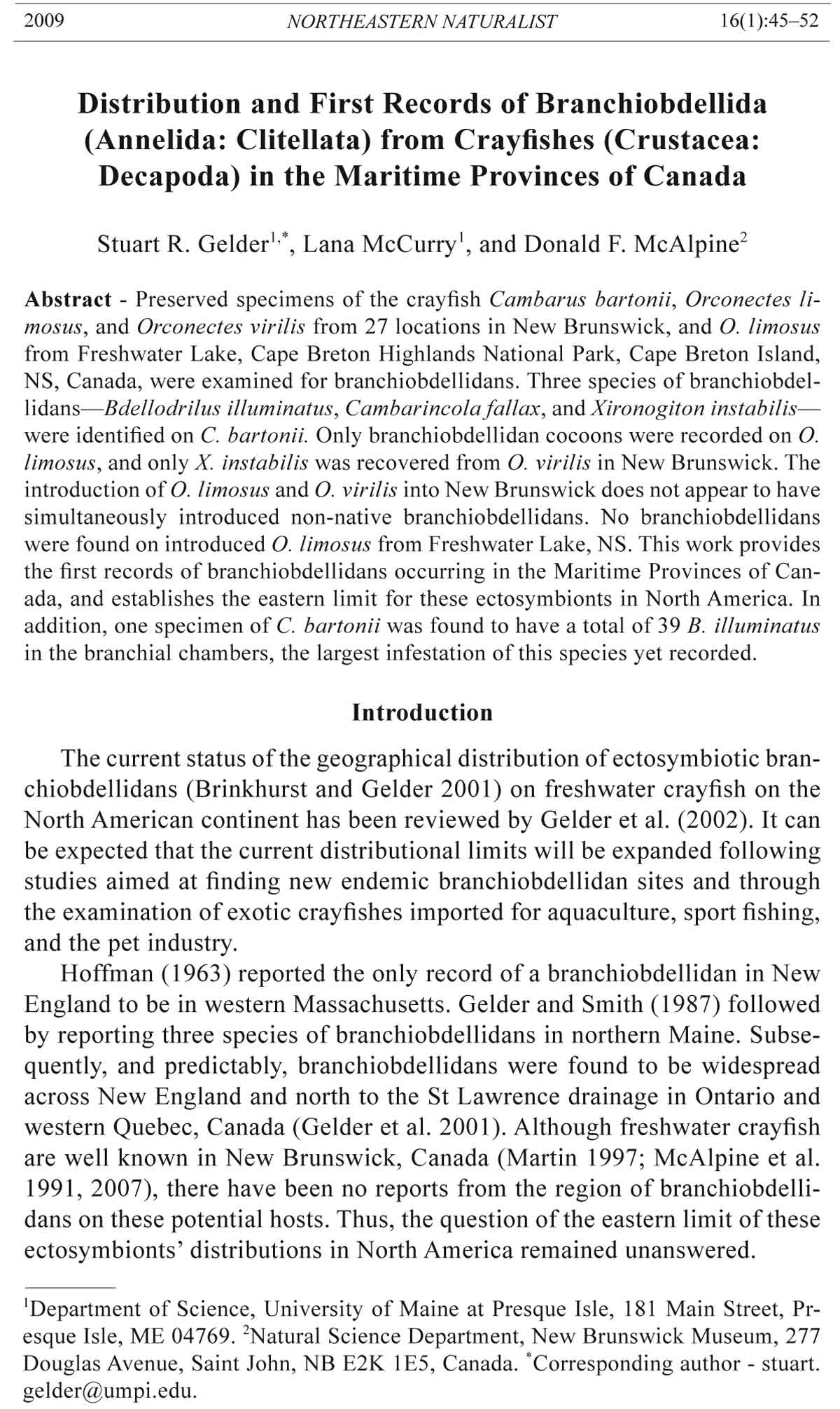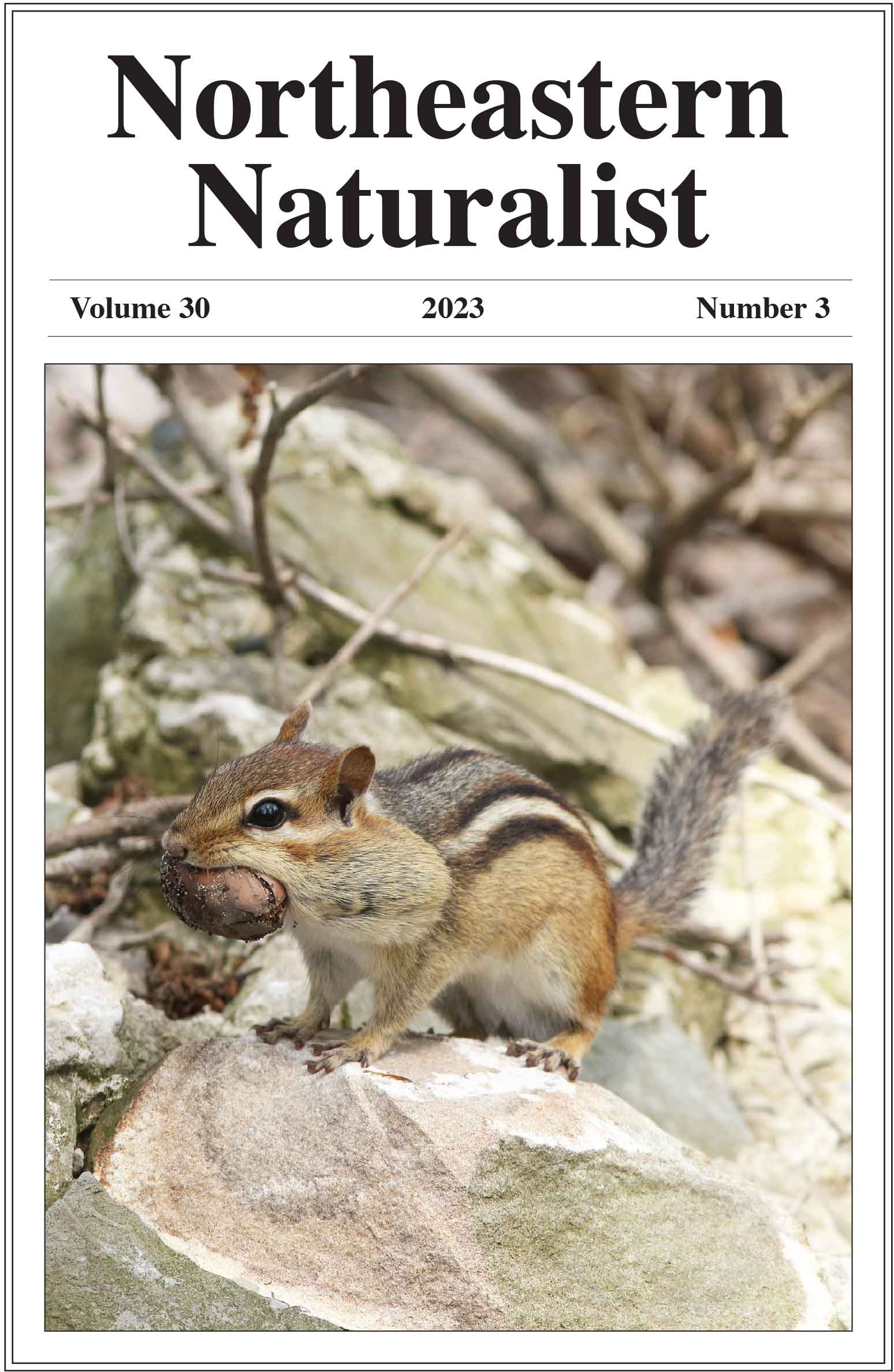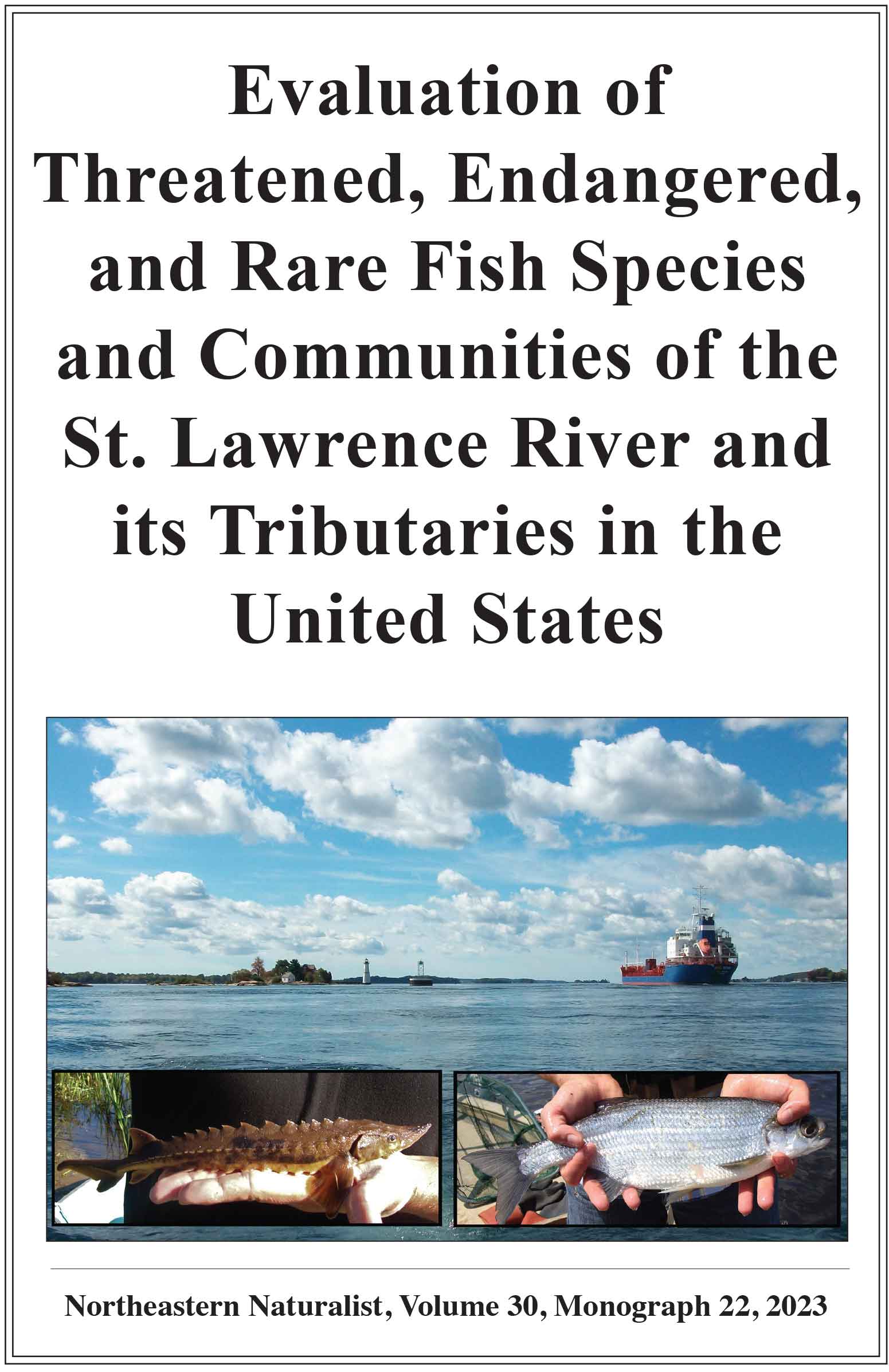Distribution and First Records of Branchiobdellida
(Annelida: Clitellata) from Crayfishes (Crustacea:
Decapoda) in the Maritime Provinces of Canada
Stuart R. Gelder, Lana McCurry, and Donald F. McAlpine
Northeastern Naturalist, Volume 16, Issue 1 (2009): 45–52
Full-text pdf (Accessible only to subscribers.To subscribe click here.)

Access Journal Content
Open access browsing of table of contents and abstract pages. Full text pdfs available for download for subscribers.
Current Issue: Vol. 30 (3)

Check out NENA's latest Monograph:
Monograph 22









2009 NORTHEASTERN NATURALIST 16(1):45–52
Distribution and First Records of Branchiobdellida
(Annelida: Clitellata) from Crayfishes (Crustacea:
Decapoda) in the Maritime Provinces of Canada
Stuart R. Gelder1,*, Lana McCurry1, and Donald F. McAlpine2
Abstract - Preserved specimens of the crayfish Cambarus bartonii, Orconectes limosus,
and Orconectes virilis from 27 locations in New Brunswick, and O. limosus
from Freshwater Lake, Cape Breton Highlands National Park, Cape Breton Island,
NS, Canada, were examined for branchiobdellidans. Three species of branchiobdellidans—
Bdellodrilus illuminatus, Cambarincola fallax, and Xironogiton instabilis—
were identified on C. bartonii. Only branchiobdellidan cocoons were recorded on O.
limosus, and only X. instabilis was recovered from O. virilis in New Brunswick. The
introduction of O. limosus and O. virilis into New Brunswick does not appear to have
simultaneously introduced non-native branchiobdellidans. No branchiobdellidans
were found on introduced O. limosus from Freshwater Lake, NS. This work provides
the first records of branchiobdellidans occurring in the Maritime Provinces of Canada,
and establishes the eastern limit for these ectosymbionts in North America. In
addition, one specimen of C. bartonii was found to have a total of 39 B. illuminatus
in the branchial chambers, the largest infestation of this species yet recorded.
Introduction
The current status of the geographical distribution of ectosymbiotic branchiobdellidans
(Brinkhurst and Gelder 2001) on freshwater crayfish on the
North American continent has been reviewed by Gelder et al. (2002). It can
be expected that the current distributional limits will be expanded following
studies aimed at finding new endemic branchiobdellidan sites and through
the examination of exotic crayfishes imported for aquaculture, sport fishing,
and the pet industry.
Hoffman (1963) reported the only record of a branchiobdellidan in New
England to be in western Massachusetts. Gelder and Smith (1987) followed
by reporting three species of branchiobdellidans in northern Maine. Subsequently,
and predictably, branchiobdellidans were found to be widespread
across New England and north to the St Lawrence drainage in Ontario and
western Quebec, Canada (Gelder et al. 2001). Although freshwater crayfish
are well known in New Brunswick, Canada (Martin 1997; McAlpine et al.
1991, 2007), there have been no reports from the region of branchiobdellidans
on these potential hosts. Thus, the question of the eastern limit of these
ectosymbionts’ distributions in North America remained unanswered.
1Department of Science, University of Maine at Presque Isle, 181 Main Street, Presque
Isle, ME 04769. 2Natural Science Department, New Brunswick Museum, 277
Douglas Avenue, Saint John, NB E2K 1E5, Canada. *Corresponding author - stuart.
gelder@umpi.edu.
46 Northeastern Naturalist Vol. 16, No. 1
Cambarus bartonii (Fabricus) (Appalachian Brook Crayfish) is widely
distributed across New Brunswick, while Orconectes virilis (Hagen) (Northern
Crayfish) is believed to be restricted to northeastern and northwestern
areas of the province (McAlpine et al. 1999, 2007). In New Brunswick, Orconectes
limosus (Rafinesque) (Spinycheek Crayfish) has been reported from
a single river system in the southwestern part of the province (McAlpine et
al. 1991). Only C. bartonii is believed to be native to the province, and to
date, there have not been any native crayfish reported from the provinces of
Nova Scotia, Prince Edward Island, or Newfoundland (Ganong 1898, Hobbs
1989). However, a recent introduction of O. virilis into Nova Scotia has extended
the eastern range of crayfish in the Maritime Provinces (Lambert et
al. 2007) and raised the possibility of exotic branchiobdellidan species being
introduced as well (Gelder 2004).
The current study was designed to establish the presence, species, and
geographical distribution of branchiobdellidans in the Maritime Provinces
of Canada by examining crayfish specimens that had been collected during
previous freshwater surveys in the region, and deposited as vouchers in
the New Brunswick Museum, Saint John, NB, Canada. These examinations
also provided the opportunity to report microhabitat or unusual infestations
should the ectosymbionts be found.
Material and Methods
Preserved specimens of C. bartonii, O. limosus, and O. virilis from 27 locations
encompassing the widest distribution of sites across New Brunswick
were examined for branchiobdellidans. Details from the New Brunswick Museum—
reference numbers, geographical locations, and crayfish species—are
given in Table 1. In addition, two collections of O. limosus from Freshwater
Lake (46.6453°N, 060.3966°W), Cape Breton Highlands National Park,
Cape Breton Island, NS, Canada, were also examined. Most crayfish from
the museum’s collection had been preserved using one of several methods:
placed in 10% formalin and subsequently transferred to 70% ethanol, placed
directly into 90% ethanol and then moved to either 70% ethanol or 10% formalin,
or frozen and then transferred to one of these two solutions. A small
number of crayfish collected specifically for this study were placed directly
into 70% ethanol, without subsequent transfer to any other solution; these
collections are shown with a suffix letter (a or b) after the site number in
Table 1.
A maximum of five crayfish were examined from each New Brunswick
collection site; however, 33 were examined from the Nova Scotia site. The
external surfaces of the crayfish were visually examined under a dissection
microscope, during which a probe was gently run through setae and cavities
to dislodge any trapped branchiobdellidans. In addition, the carapace
covering the branchial chambers was removed so that a thorough study of
the gills could be made; approximately half the number of crayfish from a
particular site was given a gill examination. The detritus and other residue
2009 S.R. Gelder, L. McCurry, and D.F. McAlpine 47
Table 1. Distribution of crayfish and their branchiobdellidans in New Brunswick, Canada. Site numbers in this table correspond to those indicated on Figure 1. Reference
# = catalog number of crayfish specimens examined during this study and deposited in the New Brunswick Museum. The number of crayfish examined from
each site is given under the abbreviation for the respective species, with the number of crayfish receiving a gill examination indicated in parentheses: Cambarus
bartonii (C.b.), Orconectes limosus (O.l.), and Orconectes virilis (O.v.). The total number of branchiobdellidans obtained per site appears under the respective species:
Bdellodrilus illuminatus (B.i.), Cambarus fallax (C.f.), and Xironogiton instablius (X.i.); the presence of cocoons is indicated by an “X”.
Site Crayfish species and #s Branchiobdellidans and #s
# Reference # Coordinates Location C.b. O.l. O.v. B.i. C.f. X.i. Cocoons
1 NBM-007094 47.183°N, 068.890°W St. Francois River 5(3) - - 0 0 0 0
2 NBM-001824 47.239°N, 068.742°W Mouth of Riviere de Crocs - - 14(3) 0 0 1 0
3 NBM-001817 47.300°N, 068.480°W Saint John River, Couturier Siding - - 5(3) 0 0 0 0
4 NBM-007059 47.288°N, 068.378°W Saint John River, Saint Hilair 5(3) - - 0 2 1 0
5 NBM-001825 47.357°N, 068.259°W Iroquois, near Saint John River - - 3(1) 0 0 0 0
5a NBM-001132 47.361°N, 068.326°W Saint John River, Edmunston - - 3(3) 0 0 0 0
5b NBM-001133 47.358°N, 068.309°W Saint John River, Edmunston 1(1) - - 2 0 2 X
6 NBM-000275 47.417°N, 068.250°W West Branch Mill Brook 3(1) - - 0 0 0 0
7 NBM-007079 48.016°N, 066.545°W Unamed beaver pond Highway 280 1(1) - - 0 0 0 0
8 NBM-007066 47.550°N, 066.516°W Eighteen Mile Brook 2(1) - - 5 0 0 0
9 NBM-007070 47.305°N, 066.187°W Quisibis River 5(3) - - 9 4 5 0
10 NBM-008241 46.969°N, 065.328°W Black River, Highway 11 - - 2(1) 0 0 0 0
11 NBM-007067 46.820°N, 066.860°W Clearwater Brook 5(3) - - 45 8 5 0
11a NBM-001797 46.392°N, 066.461°W Clearwater Brook 1(1) - - 0 16 37 X
11b NBM-001798 46.375°N, 066.401°W Sister Brook 1(1) - - 2 7 20 X
12 NBM-001131 46.520°N, 067.600°W Monquart River 1(1) - - 0 0 0 0
13 NBM-000052 46.520°N, 066.520°W Hayesville 2(1) - - 0 0 0 0
14 NBM-000054 45.970°N, 067.250°W South Hampton 2(1) - - 0 0 0 0
15 NBM-000238 46.230°N, 066.820°W Tay Creek 2(1) - - 0 0 0 0
16 NBM-000230 45.970°N, 066.700°W Garden Creek 6(3) - - 0 0 0 X
17 NBM-000232 45.970°N, 066.700°W Garden Creek 10(3) - - 0 0 0 X
18 NBM-000873 45.850°N, 066.900°W East Branch Longs Creek 5(3) - - 2 0 4 0
19 NBM-000273 45.950°N, 066.620°W Nashwaakis River 2(1) - - 0 0 0 0
20 NBM-000053 45.980°N, 066.650°W Nashwaakis 2(1) - - 0 0 0 0
21 NBM-008236 45.380°N, 067.350°W Canoose Stream - 5(3) - 0 0 0 X
22 NBM-000050 45.470°N, 066.130°W West Brown’s Flat 1(1) - - 0 0 0 0
23 NBM-000051 45.470°N, 066.130°W Brown’s Flat 1(1) - - 0 0 0 0
48 Northeastern Naturalist Vol. 16, No. 1
at the bottom of each collection jar were thoroughly searched for detached
branchiobdellidans. All ectosymbionts from a site were counted, transferred
to a specimen jar, and subsequently identified based on species descriptions
in Hobbs et al. (1967) and Gelder and Hall (1990). Representative specimens
were prepared as permanent microscope preparations following the protocol
in Brinkhurst and Gelder (2001) and have been deposited in the collections
of the New Brunswick Museum (NBM).
Results
The sites sampled for crayfish, along with the distribution of branchiobdellidans
and their cocoons, are shown in Figure 1 and Table 1.
Three species of branchiobdellidans, Bdellodrilus illuminatus (Moore)
(NBM 002596, 002601), Cambarincola fallax Hoffman (NBM 002598),
and Xironogiton instabilis (Moore) (NBM 002597, 002599, 002600,
002062) were identified in the province. Triple-species infestations of
branchiobdellidans were found at sites 9 and 11, while other collections
showed only one or two species present. The presence of branchiobdellidan
cocoons on a host demonstrated that adult worms had been present.
The cocoon was an important indicator given that O. limosus was only
found at site 21.
Specimens of O. limosus from an introduced population in Cape Breton
Highlands National Park, NS, were collected in July–November 2006 (NBM
001991–001996) and again in August–September 2007 (NBM 002603–
002607). Twenty-two crayfish from the 2006 collection were examined,
of which 11 were subjected to a gill examination; no branchiobdellidans
or cocoons were observed. From the 2007 collection, 11 specimens were
Figure 1. Map of New
Brunswick, Canada
(eastern portion truncated)
showing the
locations of crayfish
collection sites with
▲ indicating the presence,
or ● the absence
of branchiobdellidans
or their cocoons. Map
scale has required that
some site numbers refer
to multiple locations
(see Table 1).
2009 S.R. Gelder, L. McCurry, and D.F. McAlpine 49
examined, including their branchial chambers, and again no evidence of
ectosymbionts was found.
Most of the specimens of C. fallax and X. instabilis living on the exposed
surfaces of the host in life were recovered from the debris on the
bottom of the collecting jars. However, a small number of specimens
did retain their attachment to the host, allowing their microhabitats to be
confirmed. Adult X. instabilis were observed on the ventral surfaces of
the claws, along with juveniles and cocoons. Cambarincola fallax were
observed under the rostrum, on an eye, and around the mouth. Unlike
the other two species, B. illuminatus are only known from the branchial
chambers, and so specimens in this protected microhabitat were retained
in situ despite the trauma of the collection process. Infestations of B. illuminatus
were not common among the collections, but when they were
present (Table 1), numbers were small. Therefore, finding 39 B. illuminatus
in the branchial chambers of one C. bartonii from Clearwater Brook
(Fig. 1, site 11; NBM-007067) was exceptional and is the highest infestation
of this species ever reported on a single host. During the removal of
the carapace, most of the branchiobdellidans were dislodged and fell to
the bottom of the examination bowl, and so it is not known how many
individuals were in each branchial chamber; however, a few did remain
in situ between the gills and plates. In the right chamber, 50 cocoons
were attached to the basal half of the facing surfaces of the outer and median
gills above the third and fourth walking legs; 29 cocoons contained
embryos. Cocoons in the left chamber were similarly located, but on the
third and second walking legs, with 46 cocoons (28 with embryos). Crayfish
collected from the same area in 2007 (NBM 001797 and 001798) had
been placed directly into 70% ethanol on collection and not handled until
examined in the laboratory. Although this reduced the trauma to the crayfish
significantly, and more external branchiobdellidans were observed
and collected in situ (Table 1), the numbers of B. illuminatus recovered
were zero for one specimen and two for the other.
Discussion
The use of archived crayfish specimens as a source of branchiobdellidans
and other ectosymbionts is not common. However, as demonstrated
here, such studies can provide new information on the distribution of branchiobdellidans
from regions that may be difficult to access and may provide
temporal data on past branchiobdellidan status. The disadvantages of using
archived crayfish is that the methods of collection and preservation in common
use frequently causes symbionts to become detached from their host,
and because of their soft-bodied nature, branchiobdellidans can suffer significant damage. In addition, specimens are commonly (and unknowingly)
discarded with bottom debris when the ethanol is replaced. Nonetheless, the
present study has shown that crayfish transferred directly into jars with 70%
ethanol result in adequately preserved ectosymbionts and hosts.
50 Northeastern Naturalist Vol. 16, No. 1
Furthermore, the results of this present study have confirmed the
expectation that branchiobdellidans occur on endemic crayfish in New
Brunswick, Canada. That C. bartonii carried the same three species of
branchiobdellidans found in adjacent Maine (Gelder and Smith 1987)
supports the statement that New Brunswick is part of the endemic range
of both host and ectosymbionts. Although C. fallax, X. instabilis, and B.
illuminatus have well-known and spatially separate microhabitats, confirmation
of their presence at the limit of their range is important. The three
crayfish from site 11 that underwent a branchial chamber examination produced
45 B. illuminatus, with 39 taken from a single host—one that also
supported a total of 96 cocoons in the branchial chambers, 39 of which
were empty. It is interesting to speculate how many of the remaining embryos
would have hatched, and what the impact of such a large number of
juveniles would have had on the host.
The introductions of O. limosus and O. virilis into New Brunswick
(McAlpine et al. 1991, 1999) from unknown locations do not appear to have
occurred simultaneously along with non-native branchiobdellidans. It is
speculated that the single known occurrence of X. instabilis adults observed
on Orconectes in New Brunswick represents a case of host-switching from
an endemic C. bartonii. Gelder and Smith (1987) collected five O. virilis
from two sites in northern Maine and found the only branchiobdellidan species
they carried was B. illuminatus. The positive report from the Walker
Siding, Squa Pan Lake site was incorrectly given as a negative in Gelder
et al. (2001: Table 1). The Gelder et al. (2001) study of branchiobdellidans
in New England also showed that O. limosus occurred south of southern
Maine, and that when this host species carried any branchiobdellidans, it was
infested with both Cambarincola mesochoreus Hoffman and Cambarincola
philadelphicus (Leidy). Because the information in Gelder et al. (2001) was
obtained only from museum material, no estimate of infestation abundance
can be inferred from it.
The absence of crayfish in the remainder of the Maritime Provinces
has enabled the eastern limit of endemic branchiobdellidans in North
America to be established. The introduction of O. limosus into Nova
Scotia sometime between 2001 and 2005, and the species’ successful
colonization of Freshwater Lake (Lambert et al. 2007) illustrate yet again
the ease with which an invasive crayfish species can become established
in a suitable habitat (Gherardi and Holdich 1999). Often such crayfish
carry with them ectosymbionts and pathogenic organisms (Evans and
Edgerton 2002). Although no branchiobdellidans were found on the Nova
Scotia crayfish in this study, four species of ectosymbionts have been reported
on O. limosus from sites in eastern North America (Gelder 2004).
It appears from our examinations that branchiobdellidans did not survive
the transportation and introduction of the crayfish into Nova Scotia, yet
their absence during our study does not preclude their occurrence in the
Province; small surviving populations of ectosymbionts in localized areas
2009 S.R. Gelder, L. McCurry, and D.F. McAlpine 51
likely would require a number of years to increase to levels where they
would be readily detectable.
Acknowledgments
Our thanks to the University of Maine at Presque Isle, ME, for a student research
grant to Lana McCurry, and to the New Brunswick Wildlife Trust, Canada, for a
supporting grant to D.F. McAlpine. We also thank Sheldon Lambert for providing
specimens of crayfish from the Cape Breton Highlands National Park for our examination,
and to the two declared reviewers—M.A. Subchev, Institute of Zoology,
Bulgarian Academy of Sciences, Sofia, Bulgaria, and M.J. Wetzel, Illinois Natural
History Survey, Division of Biodiversity and Ecological Entomology, Champaign,
IL—for their constructive suggestions.
Literature Cited
Brinkhurst, R.O., and S.R. Gelder. 2001. Annelida: Oligochaeta including Branchiobdellidae.
Pp. 431–463, In J.H. Thorpe and A. Covich (Eds.). Ecology and
Classification of North American Freshwater Invertebrates. 2nd Edition. Academic
Press, New York, NY. 1065 pp.
Evans, L.H., and B.F. Edgerton. 2002. Pathogens, parasites, and commensals. Pp.
377–438, In D.M. Holdich (Ed.). Biology of Freshwater Crayfish. Blackwell
Science, London, UK. 702 pp.
Ganong, W.F. 1898. The crayfish in New Brunswick. Bulletin of the Natural History
Society of New Brunswick 16:54.
Gelder, S.R., and L.A. Hall. 1990. Description of Xironogiton victoriensis n.sp. from
British Columbia, Canada with some remarks on other species and a Wagner
analysis of Xironogiton (Clitellata: Branchiobdellida). Canadian Journal of Zoology
68:2352–2359.
Gelder, S.R. 2004. Endemic ectosymbiotic branchiobdellidans (Annelida: Clitellata)
reported on three “export” species of North American crayfish (Crustacea: Astacoidea).
Freshwater Crayfish 14:221–227.
Gelder, S.R., H.C. Carter, and D.N. Lausier. 2001. Distributions of crayfish worms or
branchiobdellidans (Annelida: Clitellata) in New England. Northeastern Naturalist
8:79–92.
Gelder, S.R., N.L. Gagnon, and K. Nelson. 2002. Taxonomic considerations and
distribution of the Branchiobdellida (Annelida: Clitellata) on the North American
Continent. Northeastern Naturalist 9:451–468.
Gelder, S.R., and R.C. Smith. 1987. Distribution of branchiobdellids (Annelida:
Clitellata) in northern Maine, U.S.A. Transactions of the American microscopical
Society 106:85–88.
Gherardi, F., and D.M. Holdich, 1999. Crayfish in Europe as Alien Species: How to
make the best of a bad situation? A.A. Balkema, Rotterdam, The Netherlands,
299 pp.
Hobbs, H.H., Jr. 1989. An illustrated checklist of the American Crayfish (Decapoda:
Astacidae, Cambaridae and Parastacidae). Smithsonian Contributions to Zoology
480:1–236.
Hobbs, H.H., P.C. Holt, and M. Walton. 1967. The crayfishes and their epizootic
ostracod and branchiobdellid associates of the Mountain Lake, Virginia, region.
Proceedings of the United States National Museum 123:47–74.
52 Northeastern Naturalist Vol. 16, No. 1
Hoffman, R.L. 1963. A revision of the North American annelid worms of the genus
Cambarincola (Oligochaeta: Branchiobdellidae). Proceedings of the US National
Museum 114:271–371.
Lambert, S.D., D.F. McAlpine, and A. Hebda. 2007. First establishment of an invasive
crayfish, Orconectes limosus (Rafinesque, 1817) (Decapoda, Cambaridae) in
Nova Scotia, Canada. Crustaceana 80:1265–1270.
Martin, S.M. 1997. Crayfishes (Crustacea: Decapoda) of Maine. Northeastern Naturalist
4:165–188.
McAlpine, D.F., W.E. Hogans, and T.J. Fletcher. 1991. Orconectes limosus (Crustacea:
Cambaridae), an addition to the crayfish fauna of New Brunswick. Canadian
Field-Naturalist 105:386–387.
McAlpine, D.F., T.J. Fletcher, M.A. Osepechook, and J.-C. Savoie. 1999. A range
extension for Orconectes virilis (Decapoda: Cambaridae) and a third crayfish
species for New Brunswick, Canada. Crustaceana 72:356–358.
McAlpine, D.F., A.H.E. McAlpine, and A. Madden. 2007. Occurrence of the potentially
invasive crayfish, Orconectes virilis (Decapoda: Cambaridae), in eastern
New Brunswick, Canada. Crustaceana 80:509-511.












